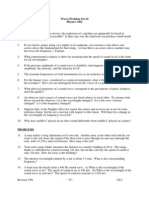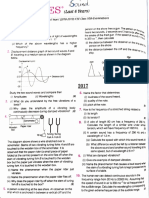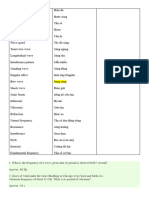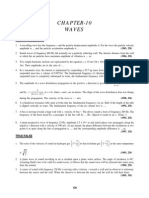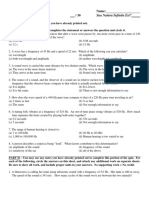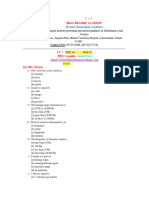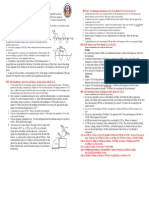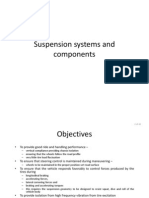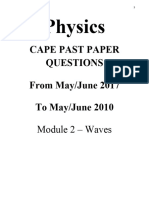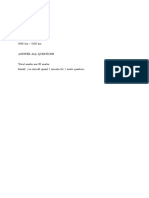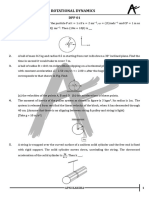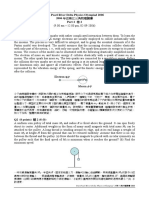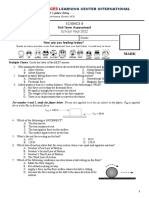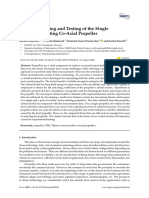AP PHYSICS 2 CLASS 10: PHYSICS OF SOUND AND MUSIC
1. Beats are the result of:
(A) diffraction
(B) constructive interference
(C) destructive interference
(D) both constructive and destructive interference
2. Sound waves are:
(A) longitudinal
(B) transverse
(C) partly longitudinal and partly transverse
(D) torsional
3. The intensity of a sound at 200 m is the intensity of sound at 100 m.
(A) 2 times
(B) 4 times
(C) 1/2 times
(D) 1/4 times
(E) the same as
4. Sound travels fastest in:
(A) cool air
(B) water
(C) warm air
(D) vacuum
5. The intensity of a sound wave refers to its:
(A) pitch
(B) loudness
(C) overtones
(D) resonance
6. A loud boom is heard after an airplane has passed overhead. This means that the airplane:
(A) is accelerating
(B) is climbing
(C) is travelling faster than Mach 1
(D) is travelling faster than the speed of light
7. A spacecraft speeding away from Earth sends out signals of a certain frequency. The signals that are received
on the Earth
(A) have a lower speed
(B) have extra harmonics
(C) have a longer wavelength
(D) have all of the above characteristics
� 8. Two tuning forks of frequencies 310 and 316 Hz vibrate simultaneously. The number of times the resulting
sound pulsates per second is:
(A) 0
(B) 6
(C) 313
(D) 626
9. A guitar player plays a 440 Hz note, and then increases the effective length of that same guitar string by a factor
of two and plays it again. The new frequency is:
(A) 440 Hz
(B) 880 Hz
(C) 220 Hz
(D) 0 Hz
10. The purpose of the intricately shaped and delicately made violin wooden body is to
(A) hold the strings tight
(B) amplify the string vibration
(C) look impressive
(D) strengthen the wood
11. A flute can be tuned to the rest of the orchestra by adjusting its length. A flute player is playing on a very hot
day and wishes to play the proper frequencies. Compared to the length in the cooler practice hall, the length of
the flute must be:
(A) slightly greater
(B) slightly less
(C) a lot less
(D) unchanged
12. A dust particle is suspended in air (floating due to a small updraft and its own low mass) when a powerful
loudspeaker emits a low frequency of 2 Hz. (This frequency cannot be heard but you can actually see the speaker
move). How will the dust particle move as a result of the speaker being turned on?
(A) The dust particle will move up and down
(B) The dust particle will be pushed across the room dust particle
(C) The dust particle will move side to side
(D) The dust particle will move in a circular path
13. When a violin string is played without fingering simultaneously with a tuning fork of frequency 440 Hz, beats are
heard at a rate of 3 per second. When the tension in the string is increased slightly, the beat frequency decreases.
What was the initial frequency of the violin string?
�14. A jet is travelling at Mach number of 𝑀 = 1.6 at an altitude of 8000 m.
(a) What is the angle of the shock wave makes with the track of the jet?
(b) Where is the jet when a person on the ground hears the shock wave?
15. You know that the pitch of a train’s whistle is about 5.0 kHz. As you stand at a railway crossing, you hear a train
whistle whose frequency is 6.0 kHz.
(a) Is the train approaching you or travelling away from you? Explain your answer.
(b) If the temperature of that day is a warm 30 ◦ C, how fast is the train moving?
16. The G string on a violin is 30 cm long. When played without fingering (violinists call it an “open string”), it
vibrates at a fundamental frequency of 196 Hz. The next higher note on a G-major scale is A (220 Hz). How far
from the end of the string must a finger be placed to play that note?
�17. The normal range of hearing of an average adult is about 20 to 20 000 Hz.
(a) What is the greatest length of an organ pipe that would have its fundamental note in this range if it is closed
at one end? Assume a speed of sound of 340 m/s at room temperature.
(b) The shortest pipes in organs are about 7.5 cm long. What is the fundamental frequency of a pipe if it is
open at both ends?
(c) For the 7.5 cm organ pipe, what is the highest harmonic that is within the audible range?
18. Three successive resonance frequencies in an organ pipe are 1310, 1834, and 2358 Hz. Is the pipe closed at one
end or open at both ends? What is the fundamental frequency? What is the length of the pipe if the speed of
sound is 340 m/s?
